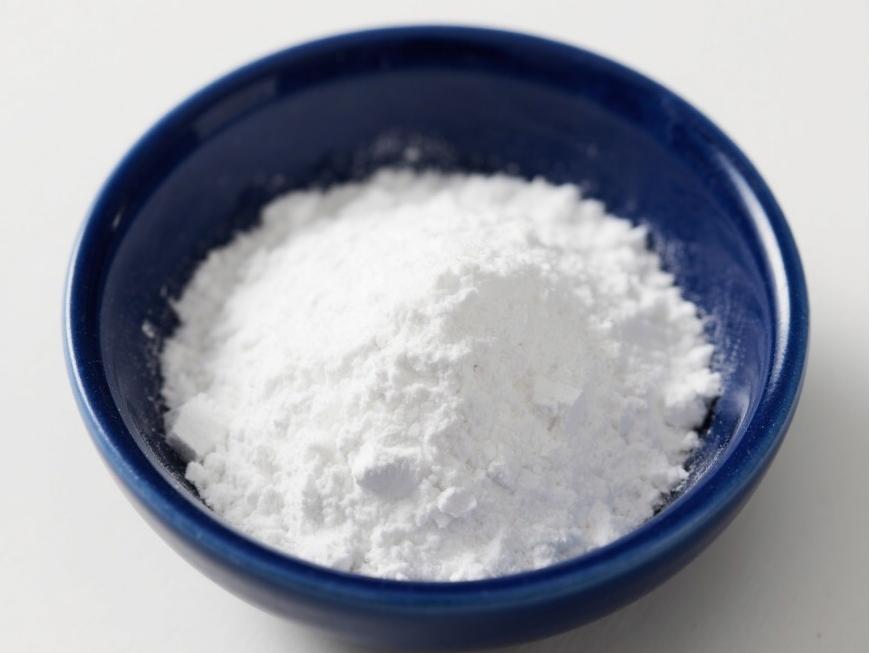고 분자량 히알루론산 분말은 무엇입니까?
1히알루론산 및 구조 조성
Hyaluronic 산(HA) is a non-sulfated, high molecular weight linear polysaccharide with a basic structure consisting 의a disaccharide unit of D-glucuronic acid 그리고N-acetylglucosamine, linked by a β- 1,3- ligand bond between 이D-glucuronic acid and the N-acetylglucosamine, and by a β- 1,4- ligand bond between the disaccharide units (Figure 1). The molecular weight of natural 루 론acid contained 에서most tissues ranges from 1000 to 10 000 kDa, and the definition of hyaluronic acid size has not yetbeen fully agreed upon.According to Naro [1], high molecular weight hyaluronic acid is defined as consisting of more than 500 basic 구조units; intermediate molecular weights are generally in the range of 200-500 kDa, and small molecular weight hyaluronic acid is generally defined as less than 200 kDa. According to Monslow etal [2], high molecular weight (HMW hyaluronan) is >1000 kDa, medium molecular weight (MMW hyaluronan) is 250-1000 kDa, low molecular weight (LMW hyaluronan) is >10-250 kDa, and oligo hyaluronan (oligo hyaluronan) is <10 kDa.
The role of hyaluronan in cell motility, cell adhesion and proliferation is mainly mediated by two hyaluronan receptors, CD44 and R-hyaluronan MM (the receptor for hyaluronan-mediated motility, also called CD168). Unlike other mucopolysaccharides, which are synthesised in the Golgi apparatus, hyaluronan is synthesised in the inner membrane of the plasma membrane of the cell by transmembrane synthetases (hyaluronan S1, hyaluronan S2 and hyaluronan S3). Hyaluronan S1 and S2 are responsible for the synthesis of large molecules of hyaluronan and hyaluronan S3 is responsible for the synthesis of small molecules of hyaluronan (<300 kDa), but hyaluronan S3 is more active than hyaluronan S1 and hyaluronan S2 The synthesised large molecules of hyaluronan are cleaved 로small molecular weights of hyaluronan by ROS (reactive oxygen radicals) and hyaluronan hydrolytic enzyme, and further hydrolysed into low molecular weights of hyaluronan. Further hydrolysis results in oligo- or oligo-hyaluronic acid. Different molecular weights have different physiological functions, e.g. medium molecular weight hyaluronic acid stimulates cell proliferation, while small molecular weight hyaluronic acid promotes cell migration. See Table 1 [3- 19].
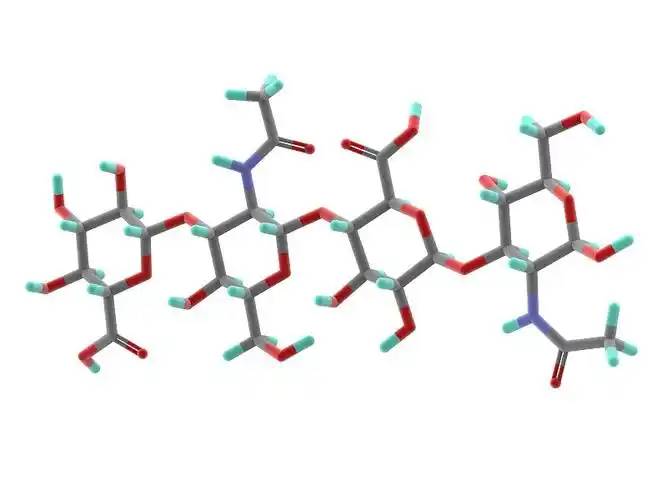
히알루론산의 생물학적 경과 2
2.1 히알루론산과 체중 감량
Hyaluronic acid has been approved as a new resource food in China (Ministry of Health Announcement No. 12, 2008), and is used as a food additive and food with health benefits in Korea, as a food additive in Japan, and as a supplement in the United States, Canada, Italy, and Belgium.
Breast milk contains the highest level of hyaluronic acid in the first week of life, which decreases to a stable level over the next two months. In general, a 70 kg adult has about 15 g of hyaluronic acid in his or her body, of which nearly one-third is degraded and synthesised on a daily basis. Hyaluronic acid is taken orally to the 피부and does not accumulate excessively in the body; more than 90% of hyaluronic acid is excreted in the breath or urine [19]. Hyaluronic acid is used for weight loss. When hyaluronic acid was administered to C57BL/6 mice at a dosage of 200 mg/kg for 8 weeks, it was found that hyaluronic acid had a good effect on weight loss, which not only reduced body mass, but also reduced adipose tissue and serum LDL-cholesterol, as well as total cholesterol and leptin, and also reduced adipose tissue hyperplasia, and ameliorated fatty liver. It is therefore hypothesised that the main mechanism of hyaluronic acid weight loss may be through the increase of the peroxisome proliferator-activated receptor PPAR-α and the inhibition of PPAR-γ [20].
히알루론산과 노화 2.2
Hyaluronic acid and hyaluronan-binding proteins are involved in cellular senescence. Researchers have found that hyaluronic acid can heal skin damage caused by UV-B exposure through histological changes and wrinkle indicators in vivo. Moreover, high concentrations of hyaluronic acid significantly affected the expression of collagen, matrix metalloproteinase (MMP-1), interleukin IL-1β and interleukin IL-6 protein factors, but not hyaluronan S-2 and transforming growth factor (TGF-β1). Reduction of proteoglycans leads to an increase in free hyaluronan fragments interacting with CD44 protein and phosphorylation of the extracellular signal-regulated kinase ERK1/2, resulting in premature embryonic fibroblast failure [21].
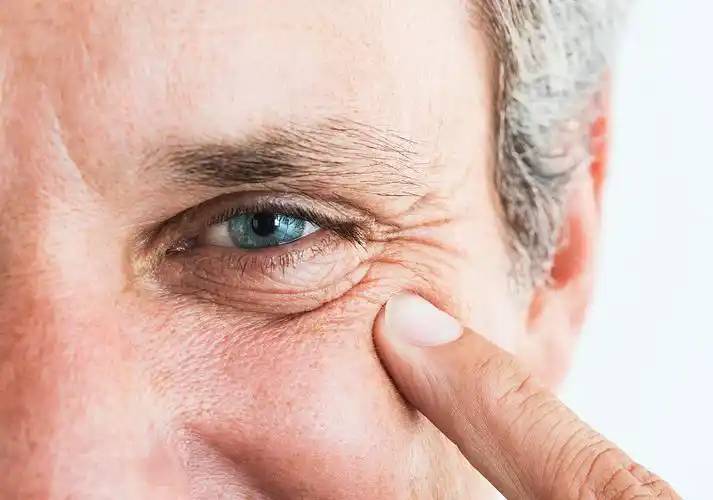
Inhibition of hyaluronan synthesis by 4-methylumbelliferone or targeting of hyaluronan S-2 by miRNA induces cellular senescence, suggesting that hyaluronan plays a role in skin ageing [22]. 게다가, hyaluronan concentration is greatly reduced in senescent MSCs and in the cell cycle matrix, mainly due to reduced expression of hyaluronidase [23]. Considering the ability of hyaluronan to inhibit fibroblast senescence induced by oxidative stress in vitro [24]. Thus, hyaluronic acid may be involved in ageing during normal and pathological processes. Further investigation of the role of hyaluronic acid in aging in disease states may shed light on the pathogenesis and aid in the development of therapeutic approaches for these diseases.
히알루론산과 성장 및 발육 2.3
Hyaluronan participates in and promotes cell growth through a variety of signalling pathways. In mice in which the hyaluronan gene hyaluronan s2 was knocked out, the heart and blood vessels developed abnormally, and at 9.5 weeks of development, the lack of an intact endocardial cushion resulted in embryonic lethality (TD Camenisch, 2000). Intraperitoneal injections of hyaluronic acid for 3-8 weeks increased the length of villi and depth of the glandular fossa in the small intestine, the depth of the glandular fossa in the colon, and the proliferation of epithelial cells in both. The opposite results were obtained with PEP-1, a short peptide that prevents the binding of hyaluronan to the receptor. These results suggest that endogenous hyaluronan can regulate normal small bowel and colon growth.
Hyaluronic acid and its binding proteins have been shown to play a role in fibroblast proliferation. Hyaluronic acid promotes TGF-β1-mediated fibroblast proliferation, and LMW hyaluronic acid or hyaluronan oligosaccharidesstimulate fibroblast proliferation under a variety of conditions, suggesting that hyaluronic acid plays an important role in tissue fibrosis. Hyaluronic acid fragments induced myofibroblast differentiation, endothelial cell differentiation, and chondrogenic differentiation [25], whereas hyaluronic acid and mouse tumour necrosis factor α-inducible protein 6 inhibited cardiomyocyte differentiation and osteoclast differentiation of 인간bone marrow mesenchymal stem cells, respectively. These data suggest that hyaluronan and hyaluronan-binding proteins regulate cell differentiation in a complex manner and that this differentiation may be related to cell type and microenvironment.
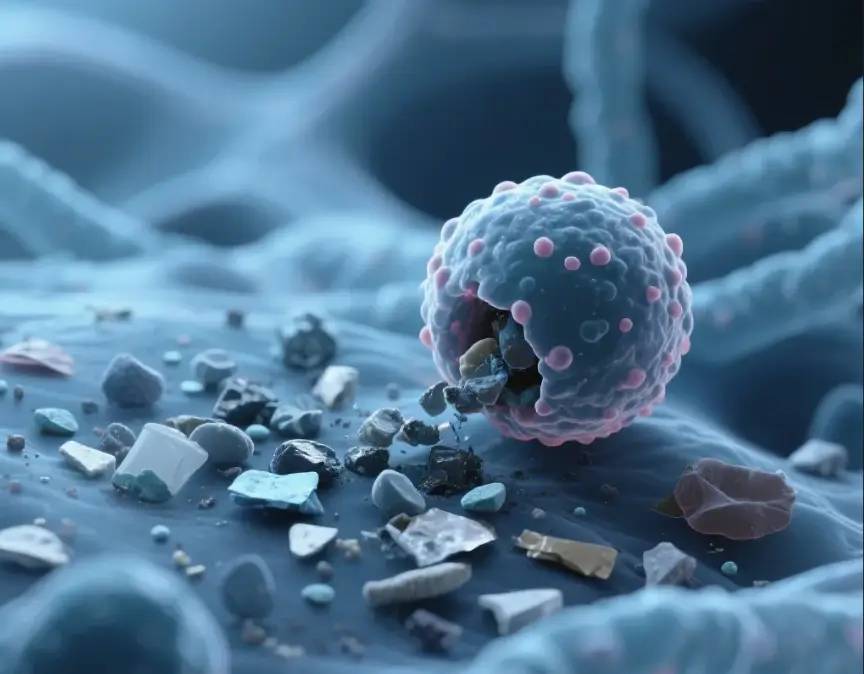
히알루론산과 면역염증 2.4
Hyaluronic acid and hyaluronan-binding proteins regulate inflammation and the repair of tissue damage by modulating the infiltration of inflammatory cells, the release of inflammatory cytokines and cell migration. Therefore, hyaluronic acid may act as an immunomodulator in human diseases [26]. Synthetic hyaluronic acid has been found to promote the expression of antimicrobial peptides in intestinal epithelial cells. Oral administration of hyaluronic acid from breast milk induced an increase in mouse defensin HβD2 homologue and MuβD3 via Toll-like receptor 4 (TLR4) and CD44 protein, and the addition of hyaluronic acid cytokines to cultured cells showed that colonic mucosal epithelial cells were more resistant to the enteropathogenic bacterium Salmonella typhimurium. Hyaluronic acid regulates cell proliferation and inflammation.
염증 성 세포 활성화 keratinocytes interleukin을 생산하는 일-6, IL-1과 종양 괴 사 인자 (TNF-α)의 생산 성의과 석방을을 통해 LMW hyaluronan, 파편으로 증가 hyaluronan 합성의 행동을 통해 부분적으로 HB-EGF, 피드백을 hyaluronan 염증 반응 섬유 아세 포를 포함 한 마이 그레이 션 및 확산에 기여 한다.히알루론산은 RMA 등에 의해 보고된 바 있다.S. hyaluronan rma 등 [25]은 히알루론산 결합 커큐민이 각질형성세포 증식을 증진시키고, 과산화수소로 인한 산화적 손상을 감소시켰으며, 긁힌 부위의 세포 이동을 개선시켰다고 보고하였다.
Hyaluronic acid can be utilised by probiotics. Probiotics can use N-acetyl-D glucosamine, a precursor of hyaluronic acid, as a nutrient, and Kim etal [27] found that Lactobacillus plantarum K8 lysate significantly increased hyaluronic acid secretion from cells. Lactobacillus lysates inhibited the Th2 response induced by interleukin 4 (IL-4)-driven stimulation and increased the Th1 response, and lactobacilli controlling the Th1/Th2 balance contributed to hyaluronic acid induction and the reduction of atopic dermatitis lesions.
Hyaluronic acid and CD44 interact with each other and have the ability to modulate T-cell activation, Th1 production, B-cell activation and regulatory T-cell functions. Recent studies have shown that CD44 functions in the adaptation of regulatory T cells by interacting with galactose agglutinin 9 [28].
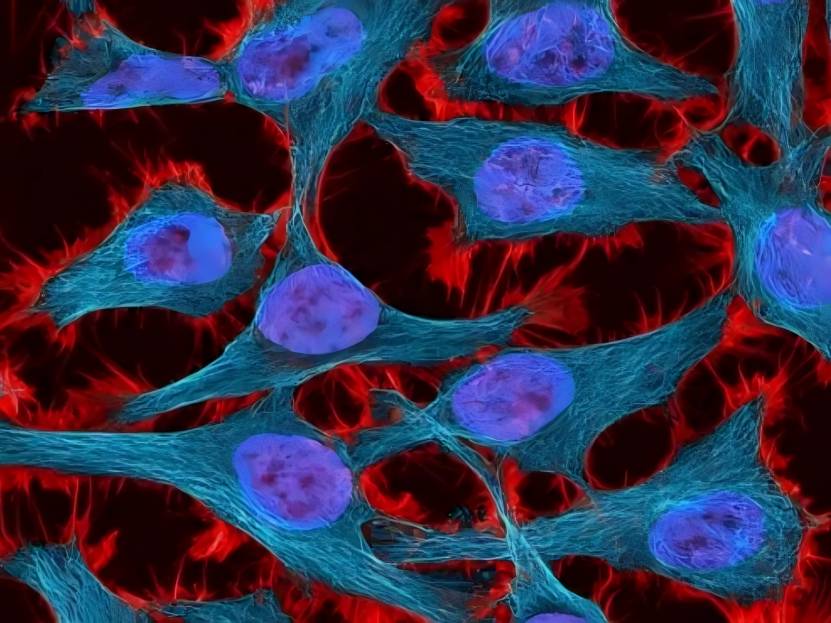
Hyaluronic acid and CD44 regulate neutrophil adhesion and recruitment. It is endothelial CD44, not neutrophil CD44, that mediates neutrophil migration, and hyaluronic acid is also capable of promoting the production of inflammatory vesicles in response to injury. In CD44-/- deficient mice, lymphocytes preferentially stayed in lymph nodes and delayed their entry into synovial joints with an inflammatory response compared to wild-type cells. CD44-/- deficient mice die from non-infectious pneumonia injury, a continuous inflammatory response characterised by impaired clearance of apoptotic neutrophils [26]. In addition, hyaluronan fragments can affect dendritic cell maturation, e.g. LWM hyaluronan fragments not only induce dendritic cell maturation but also switch on alloimmunity. In addition, hyaluronan oligosaccharidesare potential activators of dendritic cells, allowing small molecule hyaluronan fragments to promote cell migration and subsequent allergic modifications.
또한, 리포다당류의 자연 수용체인 TLR-4는 히알루로난 수용체 중 하나이다.TLR-4는 두 가지 경로를 통해 핵 전사 인자 nf-kb 단백질을 활성화시키는데, 하나는 골수 의존성 골수 분화 인자인 MyD88을 통해 친염증 사이토카인을 유도하며, 다른 하나는 제1 형 인터페론 [26]을 통해 인터페론 유발 친염증 유전자를 증가시키는 비골수의존성 MyD88 경로이다.
히알루론산과 암 2.5
Hyaluronic acid not only acts as a cellular support and hydrophilic matrix, but also regulates cell adhesion, migration, growth and differentiation (TC Laurent, 1992). These properties have led to the involvement of hyaluronic acid in a number of pathological processes. For example, in cancer, hyaluronic acid forms a protective film on the surface of tumour cells, making them less vulnerable to attack by immune cells. At the same time, tumour cells produce more hyaluronic acid or induce the production of hyaluronic acid by releasing growth factors and cytokines. Moreover, ROS-induced hyaluronan fragments contribute to the efficient expression of hyaluronan (R Stern, 2006). Tumour cells and stromal cells are able to express hyaluronan homologues and produce hyaluronan-containing extracellular matrix, which accumulates in the tumour and pericancerous stromal tissues, thus accelerating metastasis of cancer cells [29].
In addition, hyaluronic acid also regulates fibroblast and tumour invasion (Q Yu, 2000). Transforming growth factor and tyrosine kinase, when activated, regulate hyaluronan-mediated invasive cellular motility [27]. Heterogeneity analysis of probe cells using hyaluronan resulted in the identification of subtypes of infiltrating but slow-growing breast tumours. By analysing fibroblastsisolated from transgenic mice overexpressing hyaluronan S2, we found that the cells had a greater ability to invade the stroma. If the hyaluronan S2 gene is knocked out of mesenchymal cells, the invasive fibroblast phenotype is terminated, the accumulation of myofibroblasts is discharged and the development of lung fibrosis is inhibited [30].
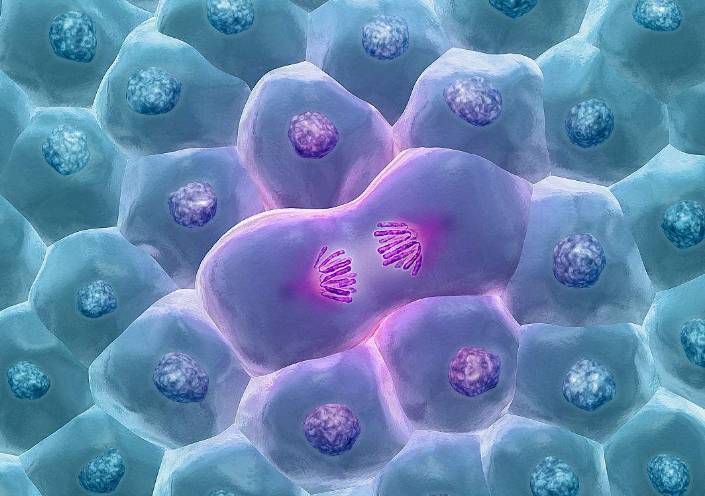
줄기세포와 히알루론산의 상관관계 2.6
The interaction of hyaluronic acid with stem cells has been studied in haematopoietic stem cells, MSCs and pluripotent adult progenitors, suggesting that hyaluronic acid and its binding proteins may interact with various stem cells through their ability to regulate tissue damage and repair processes. During stem cell differentiation, hyaluronan synthesis was enhanced 13-fold and 24-fold, most likely due to an increase in hyaluronan S2 expression. Hyaluronan is required for the production of haematopoietic cells during human embryonic stem cell differentiation. Knockdown of hyaluronan S2 resulted in inhibition of human embryonic stem cell differentiation. Hyaluronan oligosaccharides increase the stem cell properties of epi피부cells by regulating integrins. Hyaluronic acid promotes CD44-dependent migration of MSCs CD44 has long been used as a marker for stem cells, including embryonic, mesenchymal, haematopoietic and cancer stem cells. In addition, CD44 may play a role in regulating stem cell function. A recent study has shown that although CD44 is not a master stem cell gene, CD44 contributes to stem cell generation and the homeostasis of stem cells in their ecosystem. Hyaluronic acid is required to regulate the haematopoietic support function of bone marrow helper cells and is involved in haematopoietic site assembly.
히알루로난과 아폽토시스 2.7
In bleomycin-induced lung injury, hyaluronic acid protects mouse lung epithelial cells from apoptosis. High molecular weight hyaluronic acid reduces UV-induced apoptosis and inflammation in human epithelial corneal cells. Dermal fibroblasts are resistant to stress-induced apoptosis in the presence of high levels of hyaluronan s2 gene expression in the presence of hyaluronan s1/3 knockout, suggesting that hyaluronan S2 protects dermal fibroblasts from environmental stress-induced apoptosis. For inflammatory cells, hyaluronic acid appears to induce apoptosis. Hyaluronic acid appears to induce apoptosis. Hyaluronic acid induces apoptosis in activated T cells via CD44. LMW hyaluronic acid-TLR4 interaction induces apoptosis in inflammatory neutrophils. In rats, administration of hyaluronic acid with a molecular weight of 1600 kDa significantly reduced smoke-induced neutrophil infiltration, pulmonary oedema, respiratory apoptosis and mucus plugging, suggesting that high-molecular-weight hyaluronic acid may have a potential therapeutic effect on smoking-induced lung injury. In addition, cross-linking of CD44 molecule-specific epitopes rapidly induced neutrophil apoptosis in vitro and inhibited neutrophil-dependent renal injury in rats in vivo.
세포 이동과 침입에서의 역할 2.8
Hyaluronic acid mediates inflammatory cell migration to regulate the inflammatory response and tissue damage.CD44 deficiency leads to increased neutrophil migration and lung injury in E. coli pneumonia in mice. TSG6 is a potent inhibitor of neutrophil migration in an in vivo model of acute inflammation. Exogenous 저분자량 히알루론산, or LWM hyaluronic acid produced by overexpression of HYAL1, promotes the migration of dendritic cells from the skin and subsequently alters the allergic response in a TLR4-dependent manner. Hyaluronan and hyaluronan-binding proteins play a role in fibroblast migration and smooth muscle cell migration. Abnormal accumulation of hyaluronan matrix promotes fibroblast migration.
Specifically sized hyaluronan oligosaccharides stimulate fibroblast migration and excisional wound repair. both CD44 and HMMR have been shown to have a role in fibroblast migration during tissue injury. In addition, myofibroblast migration can be regulated by hyaluronic acid. These studies suggest a role for hyaluronic acid in tissue injury and fibrosis. Small molecular weight hyaluronic acid35 and high molecular weight hyaluronic acid117 showed significant differences in the migration and invasion of breast cancer 4T-1 and SKBR3 cells. In healthy people, the level of hyaluronic acid in the body is 10-100 μg/L,but in breast cancer patients, the level is as high as 200-300 μg/L, and in advanced breast cancer, it reaches 789-2343 μg/L (EH Cooper, 1988). Compared with small molecular weight hyaluronic acid, high molecular weight hyaluronic acid is able to exert a greater squeezing force on the tumour spheres and prevent the growth of cancer cells. Small molecular weight hyaluronic acid can accelerate the process of metastatic fibrosarcoma cell invasion [9].
3 전망
Over the past decades, hyaluronic acid and its hyaluronan receptor have been intensively investigated, leading to an increasing use of hyaluronic acid. Nevertheless, there are still some problems that need to be solved. The first problem to be solved is the definition of high molecular weight and low molecular weight hyaluronic acid. There is no international consensus on the distinction between high and low molecular weight hyaluronic acid, which poses a problem in elucidating the physiological effects of hyaluronic acid on cells. Secondly, high molecular weight hyaluronic acid controls the normal homeostasis of the body and shows anti-inflammatory and anti-cancer effects, while low molecular weight hyaluronic acid and oligo-hyaluronic acid show pro-inflammatory and pro-cancer effects. If the same receptor is used, but the results are significantly different, the mechanism is still not clear. In addition, how hyaluronic acid precisely regulates the occurrence and development of inflammation and tumour cells; whether oral administration of hyaluronic acid affects the intestinal flora, which in turn affects human health; and how modified hyaluronic acid (e.g., sulphated hyaluronic acid) has a different mechanism of action compared with non-modified hyaluronic acid, need to be further elucidated. The solution of these problems will certainly help to prevent diseases and maximise the use of hyaluronic acid for the treatment of human diseases.
참조
[ 1] 나오르 D. 편집:상호 작용 hyaluronic acid and 그것의 수용체 가 (CD44, RHAMM)은 염증과 암의 활동을 조절한다 [J].프론트면역톨, 2016,7:39.
[2] 몬슬로우 J,고빈다라쥬 P, 순수 E.Hyaluronan- 기능 및 structural 달콤한 조직 미세환경의 spot [J 다Front Immunol, 2015,6:231.
[3]Karbownik MS,Nowak JZ.히알루로난:참신한 항암 치료제를 향하여 [J.Pharmacol Rep, 2013,65(5):1056-1074.
[4]Papakonstantinou E, Roth M,Karakiulakis G. Hyaluronic acid:a key molecule in skin aging[J.Dermatoendocrinol, 2012,4(3):253-258.
[5] 카바시 RM,베르디아키 A, Spyridaki나, etal.피부 항상성과 염증성 질환에서 HA 대사.식품 Chem Toxicol, 2017,101:128-138.
[6]Zhu Y, Hu J, Yu T 등.분자량이 높은 히알루론산은 자궁내막의 섬유화를 억제한다 [J].의대 Sci Monit, 2016,22:3438-3445.
[7]Zhao YF, Qiao SP, Shi SL 등.분자량이 다른 히알루로난으로 3차원 미세환경을 조절하면 유방암 세포 침입 행동이 달라진다 [J].ACS 한 기초 마 인터페이스 (Interfaces) 2017년,9(11):9327~9338.
[8] 노블 PW,레이크 FR, 헨슨 PM 등.CD44의 히알루론산 활성화는 종양 괴사 인자인 α-의존성에 의해 인슐린과 같은 성장 인자인-1의 발현을 유도한다 메커니즘에 무리네곡예 [J.J Clin Invest, 1993,91(6):2368-2377.
[9] 호지 선생님-Dufour J, 고귀 한 PW, 호 튼 씨, et 알다. 유도 hyaluronan에 의한 il-12와 chemokines의 adhesion-의존적인 priming을 필요로 하지만 macrophages를 유도하지는 않는다 [부연설명]'J.J Immunol, 1997, 159 (5):2492-2500.
[10] 오오카와라 Y, 타무라 G, 이와사키 T 외.활성화 (Activation)와 변환 (transform)- ing 성장인자-hyaluronan[J]에 의한 호산구에서의 베타 생성.Am J Respir Cell Mol Biol, 2000,23(4):444-451.
[11] 피츠제럴드 카, 보위 에이지, 스케핑턴 BS 등.Ras, protein kinase C zeta 및 I kappa B kinases 1 및 2는 T-24 암세포에서 NF-kappa Bby 히알루론산 단편이 활성화되는 동안 CD44의 하류 effectors이다 [J].JImmunol, 2000,164(4):2053-2063.
[12] Slevin M, 쿠 마르 S, 개 프니 J. Angiogenic oligosaccharides 히알루로난의 경우 혈관에 영향을 미치는 여러 가지 신호경로를 유도한다 endothelial cell mitogenic과 상처 치유 반응 [부연설명]'J.J Biol Chem, 2002,277(43):41046-41059.
[13]West DC, Kumar S. Hyaluronan과 angiogenesis [부연설명]'J.Ciba는 Symp, 1989,143:187-201;토론 201-187,281-185.
[14]West DC, Kumar S. The effect of hyaluronate and its oligosaccha- 내피세포 증식과 단일층 무결성 (monolayer integrity)에 탑승한다 [부연설명]'J.Exp Cell Res, 1989,183(1):179-196.
[15] Vistejnova L, Safrankova B, Nesporova K, et 알다. 저분자량 히알루로난 매개 CD44의존 유도 일-6과 chemokines in human dermal fibroblasts potentiates 선천적 면역 반응 [J.사이토카인, 2014, 70(2):97-103.
[16] Termeer CC, Hennies J, Voith 유, et 알다. Oligosaccharides 히알루로난은 수지상세포의 강력한 활성제이다 [부연설명]'J.J Immunol, 2000년, 165 (4):1863-1870년.
[17] Pandey MS, Baggenstoss BA, Washburn J, 외.내분만을 위한 히알루로난 수용체 (HARE)는 40-400-kda에 반응하여 NF-카파브-매개 유전자 발현을 활성화하지만, 더 작거나 크지는 않은 히알루로난스 [J].J Biol Chem, 2013, 288(20):14068-14079.
[18] 가탁 S, 미스라 S, 툴 BP.Hyaluronan oligosaccharides는 phosphoinositide 3-kinase/Akt 세포 생존 경로를 억제함으로써 종양 세포의 정착-독립적인 성장을 억제합니다 [부연설명]'J.J Biol Chem, 2002, 277(41):38013-38020.
[19]Oe M, Mitsugi K, Odanaka W 외.식이성 히알루론산이 이동한다 into the skin of 쥐 [J. 과학적 세계 2014년 저널, 2014:378024다.
[20] 박 BG, 박 YS, 박 JW 외.C57BL/6 생쥐 [J]의 고지방식이에 대한 히알루로난의 엔지matic 단편의 항비만 가능성-.Biochem Biophys Res Commun, 2016,473(1):290-295.
[21] 수완 K, 초치프 K, 하타노 S 외.Versican/PG-M은 히알루로난을 세포 밖 기질로 조합하고 배아 섬유아세포의 조기 노화를 향한 cd44-매개 신호전달을 억제한다 [J].J Biol Chem, 2009,284(13):8596-8604.
[22] Lompardia SL, Papademetrio DL, Mascaro M, et 알다. 인간 백혈구 세포주는 노화를 피하고 화학 요법에 저항하기 위해 히알루로난을 합성합니다 [J].Glycobiology, 2013,23(12):1463-1476.
[23] 정엠, 권오을, 권ks 외.상관관계에 대한 증거들은- 인간 중간엽 줄기세포의 세포 노화 중 감소된 v캠-1발현과 히알루로난 합성 (tween the reduced v캠-1 expression and hyaluronan synthesis during cell senescence of human mesenchymal stem cells)Biochem Biophys Res Commun, 2011,404(1):463-469.
[24] 시릴로 N, 비시도미니 A,McCullough M, 외 히알루론산 (al. A hyaluronic acid)-기반 화합물은 섬유아세포를 억제합니다 in vitro에서 산화 스트레스에 의해 노화가 유발되고 in vivo에서 구강 점막염을 예방한다 [J].J 세포생리학, 2015,230(7):1421-1429.
[25] 샤르마 M, 사후 K, 싱 SP 외.상처 치유 활동 ofcur- 히알루론산에 conjugated cumin:in vitro 및 in vivo 평가 [J]., Artif Cells Nanomed Biotechnol, 2017,28:1~9.
[26] 지앙 D, 리앙 J, 노블 PW.인체 질병의 면역 조절제로서의 히알루로난 [J.Physiol Rev, 2011,91(1):221-264.
[27] 김 H, 김 HR, 정 BJ, et al.김치 유래 Lactobacillus plantarum K8 lysates의 경구 섭취가 피부 촉촉함에 미치는 영향.J Microb 히알루로닉 애시올 바이오 테크노 [J], 2015,25(1):74-80.
[28] 우 C, 탈하머 T, 프랑카 RF 외.Galectin-9-CD44 상호 작용은 적응 조절 T 세포의 안정성과 기능을 향상시킨다 [J].「 면책 」, 2014, 41(2):270-282.
그다지 당기 [29]. P, Basu K, Olofsson B, 외.히알루로난 합성, 분해 및 결합의 규제 완화는 유방암을 촉진한다.J Biochem, 2013,154(5):395-408.
[30]Li Y, Jiang D, Liang J 등.심한 폐 섬유증은 inva 가 필요합니다 sive fibroblast 표현형은 히알루로난과 CD44[J]에 의해 조절된다.J Exp Med, 2011, 208(7):1459-1471.


 영어
영어 프랑스
프랑스 스페인
스페인 러시아
러시아 한국
한국 일본
일본